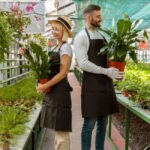Alright, let’s be real for a second: when I first moved into my Northampton home, my idea of gardening was basically “throw some plants in the ground and hope for the best.” And let’s just say… nature did not cooperate. I managed to kill a couple of succulents (which, if we’re being honest, is nearly impossible) and, somehow, the lawn looked like it was trying to emulate the Sahara Desert. 🤦♀️
But after a few seasons of trial, error, and spending way too much money on plants that, in hindsight, were clearly never meant to thrive in my yard (hello, tropical plants that lasted two weeks), I got a wake-up call. It wasn’t just about pretty flowers and cute veggies anymore—it was about being a little more responsible. Sustainable gardening became my goal. And no, I’m not talking about adding a fancy compost bin and calling it a day. I’m talking about creating a garden that works with nature, not against it.
So, if you’re looking to make your Northampton garden more eco-friendly and sustainable (whether you’re an experienced gardener or just starting out), grab a cup of tea (or wine, no judgment) and let me walk you through what I’ve learned. Spoiler: It’s easier than you think, and, no, you don’t need to be a climate scientist to make a difference. 🌿✨

1. Understanding the Northampton Climate: Why It Matters
Before I even picked out a single plant, I had to face the cold, hard truth: Northampton’s weather isn’t exactly forgiving. We’re talking cold, wet winters and those occasional scorching summer days that make you want to collapse in the shade. And I’m here to tell you—if you want to make your garden more sustainable, you need to work with the climate.
I started researching local plants that could handle the temperature swings and didn’t need constant watering. Trust me, watering is not my strong suit. I once tried to keep a fern alive by “watering it more”—yeah, that didn’t work out. 🌿💦
Northampton falls under USDA hardiness zones 6b and 7a, which means we get a fair amount of frost in the winter and unpredictable rain. It’s essential to choose plants that can handle these conditions without needing too much extra care.
2. Choosing the Right Plants for a Sustainable Garden
Now, let’s get to the good stuff—the plants! I’m talking about the hardy, low-maintenance, eco-friendly wonders that actually enjoy our weather.
Native Plants Are Your Best Friends
I know, I know—“native plants” sounds like the kind of thing you hear about in a boring documentary, but trust me, they’re not just for garden nerds. Native plants are the ultimate sustainable garden choice because they’re adapted to the local environment. That means they need less water, fewer chemicals, and less TLC to thrive.
I started with some native wildflowers, like purple coneflower (Echinacea purpurea) and black-eyed Susan (Rudbeckia hirta). Not only do they look great, but they’re also incredibly low maintenance. Seriously, the only thing I have to do is not kill them (which, shockingly, is going pretty well so far). These plants are naturally resistant to pests, and the pollinators love them. 🐝🌼
Perennials Over Annuals
Okay, I’ll be the first to admit that I used to buy a bunch of annuals every season and plant them like I was competing in a gardening competition. I’m not proud of it. But here’s the thing: annuals need to be replanted every year, and they often need a lot of care to keep looking nice. Enter perennials, the true MVPs of sustainable gardening.
I swapped my annuals for perennials, and let me tell you, it’s been a game-changer. Plants like lavender, sedum, and daylilies come back year after year, and they don’t require a ton of extra resources. Plus, it’s way less work—just plant them once, and you’re set for a season of gorgeous blooms and greenery without having to replant every single year. Less plastic, less waste—win-win! 🌸🌿
Drought-Tolerant Plants Are a Must
Let’s talk about water. It’s a precious resource, and if we’re being honest, I don’t always remember to water my plants (I swear, I’m not that neglectful—just sometimes). That’s why drought-tolerant plants are key to sustainable gardening. They can survive dry spells without demanding that you babysit them.
Plants like Russian sage, yucca, and sedum are perfect for dry areas of your garden. They don’t need constant attention, and you’ll be doing a huge favor to both your garden and your water bill. 🌞🌵
3. Soil Health: It’s Like the Foundation of Your House—But for Plants
I had no idea that soil health was such a big deal until I started researching sustainable gardening. It turns out that healthy soil is the secret sauce for growing plants that don’t require a bunch of fertilizers or pesticides. I know, soil sounds boring, but trust me, it’s actually pretty exciting once you realize it’s the key to making your plants thrive.
Compost, Baby!
When I first started gardening, I didn’t know the difference between compost and fertilizer. Spoiler alert: compost is the natural, eco-friendly solution to all of your soil problems. Instead of buying chemical fertilizers, I started composting my kitchen scraps, yard waste, and other organic materials. It’s not as hard as it sounds (if I can do it, you can), and it’s made a huge difference in my garden.
Not only does compost provide essential nutrients for your plants, but it also improves the structure of the soil, helping it retain moisture during dry spells. Plus, it reduces waste going to landfills, which is always a win. 🌱
Mulching for Moisture and Weed Control
Mulch is like a cozy blanket for your plants. I use shredded leaves, wood chips, or straw, and it keeps the soil cool during the summer, prevents weeds, and helps retain moisture. Honestly, mulch is probably one of the easiest and most effective ways to make your garden more sustainable. It’s like giving your plants a little extra TLC without having to do a ton of work. 🙌
4. Watering Wisely: Less Is More
Speaking of moisture, let’s talk about watering. We all know that overwatering can be just as harmful as underwatering (ask me how I know, sigh), and sustainable watering practices are key to making your garden eco-friendly.
Rain Barrels Are a Game-Changer
I finally bit the bullet and installed a rain barrel last year, and let me tell you, it’s been a total game-changer. Instead of using precious tap water, I collect rainwater and use it to water my garden. Not only am I conserving water, but the plants actually seem to prefer it. (Maybe it’s just me, but I’m pretty sure they’re happier with rainwater.) 🌧️🌿
Drip Irrigation: It’s Like Giving Your Plants a Drink at a Bar
If you’re like me and tend to forget to water your plants regularly, a drip irrigation system might be the answer. It’s a more efficient way to water your garden, delivering moisture directly to the roots where it’s needed most, and cutting down on water waste. Plus, it means I don’t have to worry about drowning my plants (or myself) while watering. Bonus: It’s a pretty easy DIY project if you’re into that sort of thing. 💧
5. Reducing Waste: A Win for the Planet and Your Garden
Sustainable gardening isn’t just about the plants—it’s about minimizing waste, too. I realized that there are a lot of ways to cut down on plastic use and reduce waste in my garden. Here are a few things I’ve done to make my garden more eco-friendly:
Go Plastic-Free (Or At Least Cut Back)
I’ll admit that at first, I was a sucker for those cute little plastic plant pots. But now? Not so much. I’ve started using biodegradable pots made from peat or coconut coir, and I’ve even started reusing old containers (hello, repurposed yogurt tubs) to grow seedlings. Small changes, but they add up.
Create a Wildlife-Friendly Garden
One of the easiest ways to create a sustainable garden is to make it a haven for wildlife. I planted a few native shrubs to attract birds and added a small pond to provide water for pollinators. Trust me, the birds, bees, and butterflies will thank you, and your garden will look so much livelier.
6. Conclusion: From Black Thumb to Green Warrior
So, there you have it—my journey from killing plants with kindness to becoming a sustainable gardening enthusiast. It’s not about being perfect; it’s about making small changes that add up over time. And honestly, I’ve never felt prouder of my garden. It’s greener, more vibrant, and (thankfully) much easier to maintain.
If you’re thinking of making your own garden more sustainable, start with a few changes—choose native plants, compost, and be mindful of your watering. And don’t forget to have a little fun along the way. 🌱
Remember, even if you’re starting with a blank slate (or a garden full of dead plants like I was), it’s never too late to make a difference. You’ve got this! 💪🌿
Now, if you’ll excuse me, I’m off to check on my lavender plants—no more killing them, I promise.




Comments (8)
Jason C. Cavazos
Nam saepe qui aut eligendi. Voluptatibus dolor dolores omnis dolorum nihil. Pariatur dolorem iste est consequatur est modi. Quia iure iste rerum velit sed autem.
Jason C. Cavazos
Nam saepe qui aut eligendi. Voluptatibus dolor dolores omnis dolorum nihil. Pariatur dolorem iste est consequatur est modi. Quia iure iste rerum velit sed autem.
Jason C. Cavazos
Nam saepe qui aut eligendi. Voluptatibus dolor dolores omnis dolorum nihil. Pariatur dolorem iste est consequatur est modi. Quia iure iste rerum velit sed autem.
Jason C. Cavazos
Nam saepe qui aut eligendi. Voluptatibus dolor dolores omnis dolorum nihil. Pariatur dolorem iste est consequatur est modi. Quia iure iste rerum velit sed autem.
Jason C. Cavazos
Accusamus enim a rerum veniam modi sint. Eos officiis et illo harum voluptate eligendi. Quo atque nesciunt consequatur in iusto neque fugiat. Ipsam ut quidem similique sit qui est eligendi cum.
Jason C. Cavazos
Accusamus enim a rerum veniam modi sint. Eos officiis et illo harum voluptate eligendi. Quo atque nesciunt consequatur in iusto neque fugiat. Ipsam ut quidem similique sit qui est eligendi cum.
Jason C. Cavazos
Accusamus enim a rerum veniam modi sint. Eos officiis et illo harum voluptate eligendi. Quo atque nesciunt consequatur in iusto neque fugiat. Ipsam ut quidem similique sit qui est eligendi cum.
Jason C. Cavazos
Accusamus enim a rerum veniam modi sint. Eos officiis et illo harum voluptate eligendi. Quo atque nesciunt consequatur in iusto neque fugiat. Ipsam ut quidem similique sit qui est eligendi cum.